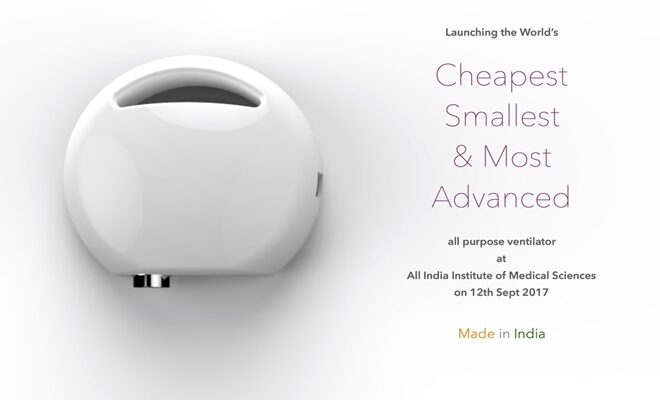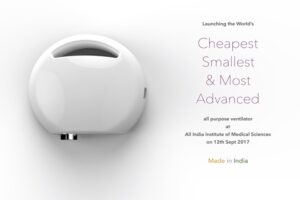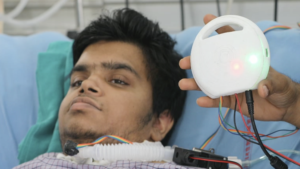SMALLEST AND CHEAPEST VENTILATOR
A simple medical ventilator is used to pump out air into and out of lungs of patients who are unable to breathe sufficiently. There are lots of patients all over the world who are on or required to be on ventilator for prolonged period of time, but can’t afford it due to its high costing. To overcome this problem, cheapest and smallest ventilator has been developed by young 25 year old scientist working as head of Robotics and Research in A-SET Training and Research Institute in collaboration with Dr Deepak Agarwal who is a neurosurgeon at AIIMS (New- Delhi).
This ventilator is 450 times smaller and it costs between RS 10000 and RS 15000. Other conventional ventilator which are used costs around RS 5-15 lakh and are bulky to handle, because it requires oxygen cylinder with it. This portable ventilator have life of one month and no other investment is required because it used room air instead of external oxygen cylinders.
HOW IT WORKS???
1) Ventilator currently used by healthcare system pushes air into the patient’s lungs at a fixed frequency that not necessarily always matches the patient’s breathing pattern and may cause low oxygen saturation.
2) This ventilator uses an artificial intelligence algorithm which understand the breathing pattern and controls the air flow and pressure and synchronizes as per patient’s best requirement.
3) Since there is no requirement of external oxygen cylinders, this device takes oxygen from atmosphere from air content which already contains 20% of oxygen and is required for almost all patients.
4) A pressure sensor monitors the relative pressure of patient’s air passage over 1000 times in a minute.
5) This collected data is sent to computing unit where inhale and exhale time is calculated.
6) During inhale phase, the air is induced to patient’s lungs under controlled pressure rate monitored by controlling unit.
7) Once the lung is filled, the air flow is stopped.
8) During exhale phase, another channel is assigned for lungs to exhale the air into the atmosphere.
2) This ventilator uses an artificial intelligence algorithm which understand the breathing pattern and controls the air flow and pressure and synchronizes as per patient’s best requirement.
3) Since there is no requirement of external oxygen cylinders, this device takes oxygen from atmosphere from air content which already contains 20% of oxygen and is required for almost all patients.
4) A pressure sensor monitors the relative pressure of patient’s air passage over 1000 times in a minute.
5) This collected data is sent to computing unit where inhale and exhale time is calculated.
6) During inhale phase, the air is induced to patient’s lungs under controlled pressure rate monitored by controlling unit.
7) Once the lung is filled, the air flow is stopped.
8) During exhale phase, another channel is assigned for lungs to exhale the air into the atmosphere.
Since there is very less time after inhale and exhale phase, delay in computation can hamper the entire process.
Advantages:
1) It is portable and cost effective.
2) No oxygen cylinders are required.
3) It can be operated using android app connected via Bluetooth.
4) No professional expertise is required.
5) It doesn’t work on fixed frequency.
6) It can be used in all situations where normal ventilators are used.
Pic Courtesy: Twitter/ Prof. Diwakar Vaish
Editor: Taher Ujjainwala



Great innovation it may help many people good work
Yes.. Surely one of the best unique innovation we have came across… If you like please Share and Subscribe our newsletter. Thank You!!